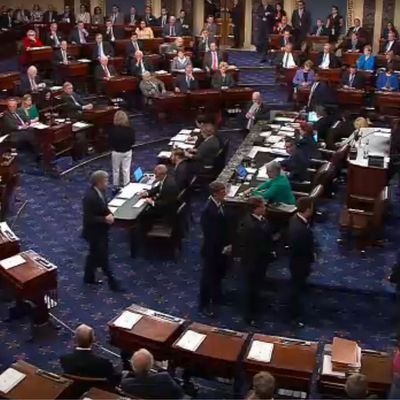
Republicans love wide open, empty spaces. From the Oval Office to many Twitter precincts, they like to brandish maps of the 2016-presidential-election results by congressional district, or even by county, implicitly suggesting the bloody-red hues signify political dominance:
This is extremely misleading because Americans are not distributed equally by geography, of course, and acreage does not receive representation in our electoral system, right? Wrong: There’s the United States Senate.
Those who look at all the close presidential elections since 2000 and the roughly equivalent levels of party self-identification and assume the two parties have an equal shot at political power may be missing a subtle shift with profound implications: There are now far more “red” than “blue” states, and they have equal representation in the Senate.
As David Wasserman explains at FiveThirtyEight:
In the last few decades, Democrats have expanded their advantages in California and New York — states with huge urban centers that combined to give Clinton a 6 million vote edge, more than twice her national margin. But those two states elect only 4 percent of the Senate. Meanwhile, Republicans have made huge advances in small rural states — think Arkansas, North and South Dakota, Iowa, Louisiana, Montana and West Virginia — that wield disproportionate power in the upper chamber compared to their populations …
Republicans don’t even need to win any “swing states” to win a Senate majority: 52 seats are in states where the 2016 presidential margin was at least 5 percentage points more Republican than the national outcome. By contrast, there are just 28 seats in states where the margin was at least 5 points more Democratic, and only 20 seats in swing states.
You can see this played out on the current and future Senate landscapes, where sometimes sharp partisan differences occur because only one third of the seats are up in any given cycle.
Democrats have a famously difficult landscape for 2018, defending 25 of 34 seats, with ten Democrats running in states carried by Donald Trump last year (only one GOP incumbent, Dean Heller of Nevada, is running in a state carried by Hillary Clinton).
It gets much better after 2018, right, but the “red state/blue state” factor limits Democratic opportunities for gains, even in theoretically favorable years.
In 2020, Republicans will be defending 22 Senate seats, with Democrats only defending 11 in 2020. But only two of those 2020 Republicans will be running in states carried by Clinton in 2016, and both of those were relatively close states (Colorado and Maine). In 2022, Republicans will again have to defend 22 seats. But not a single one is in a 2016 blue state.
Republicans having an advantage in the Senate carries no guarantees: At the moment, the Cook Political Report shows Democrats leading in all ten 2016 red states where they are defending Senate seats. If Democrats hold their own in the Senate next year, and particularly if they do well in the 2020 presidential contest, there is no reason they cannot gain control of the upper chamber in 2020 and hold it through 2022. But they’ll be fighting a small-state bias built right into the system by the Constitution, which makes a mockery of the idea of equal representation.






























